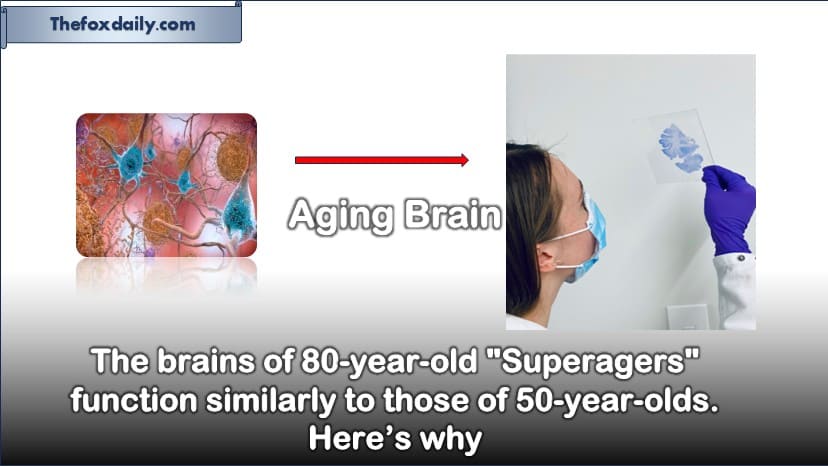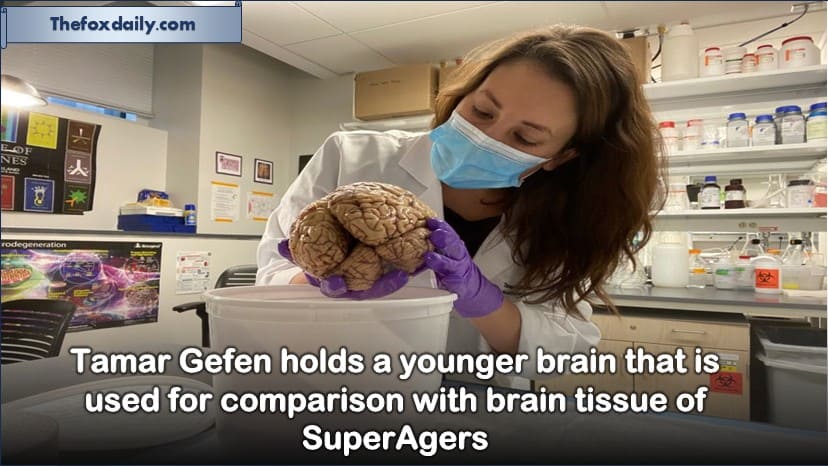
It’s a fact of life that the human brain shrinks with age, impacting memory. However, a select number, referred to as “SuperAgers,” have a brain that can fight back. For these individuals, recollections are as vivid as they were thirty or more years ago.
Carol Siegler is a SuperAger who resides in the Palatine suburb of Chicago. She claimed to have competed “as a gag” and won the American Crossword Puzzle Tournament for her age category at the age of 82.
“I did well enough on my two “Jeopardy!” auditions to be invited to the live auditions. In 2022, at the age of 85, Siegler told me, “Then Covid hit.”
According to Tamar Gefen, an associate professor of psychiatry and behavioral sciences at Northwestern University’s Mesulam Institute for Cognitive Neurology and Alzheimer’s Disease in Chicago, Siegler is still going strong today and will soon turn 90.
Gefen works at Northwestern’s SuperAging Program, where 113 SuperAgers are being studied at the moment. However, 80 SuperAgers have given the program their brain tissue over the last 25 years, which has produced some intriguing findings.
Gefen discussed those decades of effort with TFD. She coauthored a fresh analysis of the study that was released on Thursday in the Alzheimer’s Association journal, Alzheimer’s & Dementia.
This interview has been lightly edited and condensed for clarity.
TDF: How would you characterize a SuperAger, and what insights have you gained into their conduct over time?
Tamar Gefen: To be eligible for Northwestern’s SuperAger program, an individual must be older than 80 and pass a battery of cognitive tests. The study only accepts participants whose episodic memory, or recall of routine events and past personal history, is on par with or superior to that of cognitively normal individuals in their 50s and 60s.
Less than 10% of the nearly 2,000 people we tested who believed they might be SuperAgers fit the requirements. We have examined over 300 SuperAgers over the last 25 years, some of whom have given their brains for study.
SuperAgers appear to be very gregarious, which is one of their main characteristics. They are frequently involved in their communities and cherish connections. This is intriguing because maintaining social interactions is a known protective characteristic, and loneliness is known to be a risk factor for dementia development.
A sense of independence, freedom, and autonomy is another trait shared by all SuperAgers. They are making choices and leading their lives in the manner in which they desire.
I firmly believe that being sociable is not the only factor in successful aging. If a person feels trapped, tethered or burdened, especially in a vulnerable state like poor health or older age, I think it can encroach on their entire psychosocial being.
However, SuperAgers exhibit a wide range of beneficial activities. We have SuperAgers who are not physically active, have diabetes, heart disease, and eat no better than their counterparts of the same age.
Every night, one SuperAger consumes four beers. “Maybe it’s done me wrong, but I’ll never know,” he says with a giggle. Would he have lived to 108 instead of 98 since he lacks an identical twin to compare his actions to? We’re not sure.
TFD: Studying donated brain tissue has led to several of your most fascinating findings. What have you learned about the SuperAger brain’s memory center?
Gefen: According to our research, SuperAgers have thicker cingulate cortex regions, which are linked to motivation, attention, and cognitive engagement, especially when compared to those in their 50s and 60s.
We discovered that SuperAgers have three times less tau tangles in the hippocampus, the brain’s memory core, than their “normal” counterparts. One of the main indicators of Alzheimer’s disease is abnormal tau protein production.
Tau also attacks the primary neurons of the cholinergic system, which maintains our attention in day-to-day activities, in Alzheimer’s disease. However, that doesn’t occur in a SuperAger’s brain. As a result, for unknown reasons, the cholinergic system seems to be stronger and probably more malleable and adaptable.
I find SuperAgers to be concentrated, so that’s fascinating. They are able to actively listen, participate, and pay great attention. After 30 minutes, how else could they remember 13 of 15 random words? I see them using a chisel to etch the words into their cortex.
The entorhinal cortex, a region crucial for memory and learning that is directly connected to the hippocampus, also contains larger, healthier cells in SuperAger brains. By the way, one of the first parts of the brain to be affected by Alzheimer’s disease is the entorhinal cortex.
In a different study, we meticulously assessed the size of the neurons and looked at each layer of cells in SuperAgers’ entorhinal cortex. We discovered that SuperAgers possessed enormous, plump, intact, gorgeous, and enormous entorhinal cortex neurons in layer two, which is the layer most crucial for information transmission.
The fact that their entorhinal neurons were much bigger than those of people much younger—some even in their 30s—was an astounding discovery. This indicated that there is a structural integrity component at work; the neuron’s skeleton, architecture, and bones are stronger.
In order to identify what makes these neurons unique, comprehend their molecular signatures, and ascertain whether these signatures are present in other neuron types in SuperAgers’ brains, we are extending our research on these neurons. If true, how and why are these same neurons more susceptible in those who have Alzheimer’s disease?
TFD: Based on your studies, what conclusions have you drawn about how a SuperAger’s brain responds to stress, illness, and injury?
Gefen: In order to comprehend how the immune cells in SuperAgers’ brains react to illness and adjust to stress, we’re examining the inflammatory system in their brains. After it reaches a certain point, inflammation plays a significant role in cell death in Alzheimer’s disease and almost all other neurodegenerative illnesses.
SuperAgers’ white matter has fewer activated microglia, the brain’s resident immune cells, than those of their contemporaries of the same age. Transporting information from one area of the brain to another, white matter serves as the brain’s super highway.

This is how it operates: When there is an antigen or illness, usually something harmful in the brain, microglia are triggered. But occasionally, immune cells, including microglia, go into overdrive and become hyperactive, which can lead to inflammation and even injury.
However, SuperAgers have fewer active microglia in their brains. Microglia levels were really comparable to those of adults in their 30s, 40s, and 50s. That could mean there is less junk or disease in the brain of a SuperAger so the microglia have no need to be active. Alternatively, it might indicate that microglia are effectively eliminating illness or poisons, and that their increased plasticity and adaptability allow them to activate, react, and then relax.
All of this is intriguing; it’s possible that, similar to the layers of cells we discovered in the entorhinal cortex, the immune system of a SuperAger brain is more robust or adaptive at the cellular level.
TFD: It seems like luck determines whether you were born with the genes that protect your brain. What does that signify going forward?
Gefen: Genetics can be complex. It’s not just about whether you have a gene or not; it’s also about how your internal and external surroundings interact to affect how a gene is “turned on,” or expressed; some genes will express themselves more strongly, while others will express them less. This is the puzzle’s epigenetic component.
We are beginning to closely examine a list of potential genes that are also involved in senescence, longevity, cell repair, and cognitive reserve, to mention a few.
I’m excited about that, not only for the genetics that are heritable from parents, but also genetics at the cell level, that enable each neuron or immune cell to carry out its respective job within the brain. Given how quickly technology is developing, I have no doubt that we will reach a moment where genetic modification or prevention will be a part of the strategy.
It is obvious that Alzheimer’s disease cannot be solved in a single step. It’s just not going to happen, even though I know we all want that one simple solution.
Creating a customized cocktail for prevention or treatment will require the collaboration of numerous teams and experts. It will take time, but I believe it is achievable.
For breaking news and live news updates, like us on Facebook or follow us on Twitter and Instagram. Read more on Latest Health on thefoxdaily.com.



COMMENTS 0